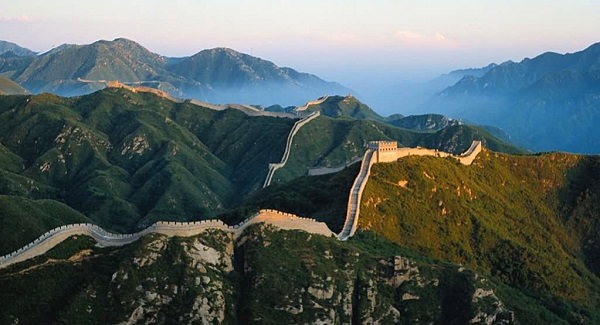The 20 Facts That Make Chinese Proud
The history of Ancient China goes back over 4000 years. Its long history has seen many “Firsts” in the world. the first paper currency, the first compass and so on. Here we select 20 facts of Ancient China that all chinese are proud of today.

1. The Great Wall – the longest wall in the world
The Great Wall of China is the longest wall in the world and has a main-line length of 3460km. Construction of the wall began during the reign of Emperor Qinshihuang (221-210BC). It measures at least 7.6 metres in height and up to 9 metres in width.
2. The Silk Route – the oldest trade route between east and west world
The Silk Route is the oldest trade route between Eastern and Western Worlds. The 4500 kilometer route is actually trading network of caravan tracks connecting Chang’an (now the present day city of Xi’an), China in the East and Rome, Italy in the West. This ancient route lasted for centuries from the Han Dynasty in the 2nd century BC up through the 15th century AD.
3. City Wall of Nanjing – the longest city wall in the world
Nanjing City Wall, constructed during the Yuan and Ming Dynasties between 1365 and 1386. It used 200,000 laborers to move 7 million cubic metres of earth. The wall originally stretched over 30km, making it the longest city wall in the world. Now, with about two thirds of the wall are still intact.
4. Earliest record of Halley’s Comet
Comets have been observed and recorded in China since the Shang Dynasty (1600-1046 BC). And the first verified record of Halley’s Comet was made by Chinese astronomers in China in 240 BC.
5. Gan and Shi’s Celestial Book – the earliest astronomic work in the world
Gan and Shi’s Celestial Book, written in the Warring States Period 476 BC to 221 BC, is the regarded as the earliest astronomic work in the world. It boasts a record of the names of over 800 stars, the positions of 121 which have been ascertained.
6. The first measurement of the meridian ever done in the world
Between 724-725, Tang Dyansty astronomer Seng Yixing led a large-scale project to identify the astro-geodetic measurement of 13 places and concluded that the length of a degree of the meridian line was 351.27 li (131.3 kilometers) by Tang measurement. This was the first measurement of the meridian ever done in the world.
7. Sinan – the first compass in the world
The magnetic compass was first invented as a device for divination as early as the Chinese Han Dynasty (Since about 206 BC ). The compass was used in Song Dynasty China by the military for navigational orienteering by 1040-1044.
8. Houfeng Didong yi – the earliest instrument for forecasting and reporting earthquake in the world
In 132 AD, Zhang Heng, a great scientist in the Eastern Han Dynasty, invented the seismograph – the earliest instrument in the world for forecasting and reporting the movement of an earthquake.
9. The first nation who invented paper
China was the first nation who invented paper. The earliest form of paper first appeared in the Western Han Dynasty (206BC-23AD). The paper unearthed in a Han tomb in Gansu Province is by far the earliest existing ancient paper, tracing back to the early Western Han Dynasty.
10. The earliest printing technique
Printing is one of the four great inventions of ancient China. Block printing, appeared in early Tang Dynasty, was the first technique put into use. The earliest dated printed book known is the “The Diamond Sutra“, printed in China in 868 CE.
11. First paper currency
Paper currency first developed in Tang Dynasty China during the 7th century — mostly in the form of privately issued bills of credit or exchange notes.
12.First gunpowder weapon
Gunpowder is popularly listed as one of the “Four Great Inventions” of China. Song dynasty of China made the first gun ever in 500 AD. It acted for ejecting a projectile by using gun powder.
13. Simuwu Rectangle Ding – the heaviest piece of bronze ware in the world
The Simuwu Rectangle Ding bronze was built at the end of the Shang Dynasty some 3,000 years ago. The opening of the Simuwu Rectangle Ding is 110 cm long and 78 cm wide; its sides are six cm thick and the loop handles are 133 cm high. The whole ding weighs 75 kilograms and is the heaviest piece of bronze ware in the world.
14. The first lacquer in the world
The earliest extant lacquer object, a red wooden bowl, was unearthed at a Hemudu culture (ca. 5000-4500 BCE) site in China. By the Han Dynasty (206 BCE – 220 CE), many centres of lacquer production became firmly established.
15. The Art of War – the earliest military book in the world
Written in China more than 2,000 years ago, Sun Tzu’s classic The Art of War is the first known study of the planning and conduct of military operations. Sun Tzu’s The Art of War
is as timely for business people today as it was for military strategists in ancient China.
16. First to put forward the concept of decimal number in the world
Liu Hui in the third century was the first person to put forward the concept of decimal number in the world. He approximated by approximating circles polygons, doubling the number of sides to get better approximations. He approximates pi as 3.141014 and suggested 3.14 as a practical approx. This is the most accurate estimate of ancient mathematicians.
17. Zhaozhou Bridge – The oldest existing stone-arched bridge in the world
Zhaozhou Bridge, also known as Anji Bridge, is a large stone-arched bridge designed by ancient architect Li Chun in Zhaozhou County, Hebei Province. The bridge was constructed in the years 595-605. It is the largest and oldest stone-arched bridge in the world.
18. Yongle Encyclopedia – the world’s largest known general encyclopedia at its time.
The Yongle Encyclopedia was a Chinese compilation of information commissioned by the Ming Dynasty emperor Yongle in 1403 and completed by 1408. It was the world’s largest known general encyclopedia at its time.
19. Zheng He – the first naval explorer
Zheng He is believed to have set foot upon lands that Europeans had yet to discover.From 1405 to 1433 Zheng He sailed the Western Sea (Indian Ocean) seven times with a fleet consisting of 317 ships with almost 28,000 crewmen. The largest of his ships measured about 130 metres long and would have made Columbus’ flagship Santa Maria look like a rescue boat.
20. Mafeisan – the earliest anesthetic ever existed in the world
Mafeisan was an anesthetic for surgical use created by Hua Tuo (145 – 208A.D.) , the famous doctor in ancient China. Mafeisan was the earliest anesthetic ever existed in the world. In the western countries, the first record of general anesthesia surgery did not appear until the early 18th century, which was over 1600 years later than the deeds of Hua Tuo.

